
scrounge: /skrounj/ informal verb: to actively seek [books] from any available source
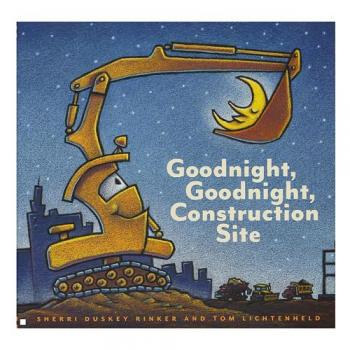
Book Scrounger's note: The following is a guest review by Doug, a.k.a Professor Puzzler:
I just wrote a book review for Little Beaver and the Echo; this is another book that I absolutely love the pairing of text (by Sherri Duskey Rinker) and illustrations (by Tom Lichtenheld). As a matter of fact, in Goodnight, Goodnight, Construction Site, I would say that I like the illustrations more than the text. Don't get me wrong, I do like the text -- although there are some rhythmic stumbles in the poetry that caught me off-guard the first couple times I read it. But when I'm reading this book to my kids, I'm barely paying attention to the words I'm reading, because I'm looking at all those delightful illustrations.
The use of color is great, and in particular, the illustrator used different tinted papers for the various "times of day" illustrations, which resulted in all the daytime pictures, all the sunset pictures, and all the nighttime pictures each having the appropriate color warmth to them, because each shared a base color.
The story (which isn't really a story; there's no real plot to the book) focuses on the activities of five construction vehicles: a crane truck, a cement mixer, a dump truck, a bulldozer, and an excavator. Each machine (you can see the excavator in the picture here) has its own unique personality and facial features. Each vehicle has a section of the book, ending with the vehicle snuggling up for a good night's sleep after a long day's work. After each section, the book ends with a couple pages of wishing the team a good night.
If you have young children who are fascinated with construction vehicles, you should not be without this book!
Scrounged From: Amazon, for our four-year-old
Format: Hardcover
Author: Sherri Duskey Rinker
Illustrator: Tom Lichtenheld
Pages: 32
Content Advisory: None
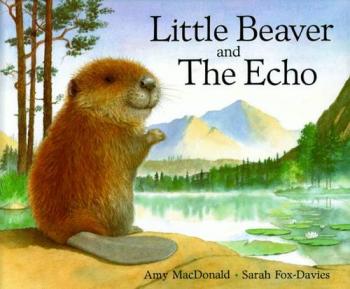
Book Scrounger's note: The following is a guest review by Doug, a.k.a. Professor Puzzler.
Little Beaver and the Echo is a wonderful picture book that tells the story of a lonely little beaver who -- while crying about how lonely he is -- hears a voice from across the pond crying about the same thing. Surprised, he sets off in his canoe to see if he can find that lonely little animal on the other side of the pond.
Along the way he makes new friends, and learns that the creature on the other side of the pond has also made new friends. It's a wonderful story about the simplicity with which friendships can be discovered, formed, and cultivated.
My children enjoy the story, and I love the combination of text and beautiful artwork.
This fall I took my 4-year-old son to a "kinderkonzert" -- a concert for children. We chose to go specifically because the concert was going to involve the telling of the story of Little Beaver and the Echo. What I didn't know was that the author, Amy MacDonald, was going to be present, and would be narrating the story herself. That was a wonderful surprise.
After the concert, my son and I spoke with her for a few minutes, and told her how much we enjoyed her book. I said, "And it's not just the story -- you had a wonderful illustrator to work with for this book!"
Her response: "Yes, I consider myself quite blessed in the choice of illustrators."
Blessed indeed. The combination of text and illustrations is delightful. I just found out, while writing this review, that there is a sequel to this book: Little Beaver and the Big Front Tooth, with the same illustrator!
Scrounged From: A gift to our two-year-old
Format: Paperback
Author: Amy MacDonald
Illustrator: Sarah Fox-Davies
Pages: 32
Content Advisory: None
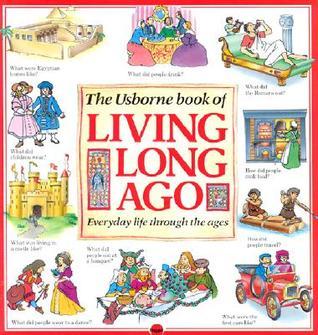
The Usborne Book of Living Long Ago is one of my favorite Usborne books from my childhood. Well, we actually had it as individual books, and we didn't have the fourth section, so I was even more excited to see a version where they're all together. I don't know whether this was ever used in my schooling or not -- it probably was, but what I remember most is finding it/them on the bookshelf as an older child and going back to it over and over again, looking at all the interesting tidbits.
In typical Usborne illustrations (lots of detail and explanations), we get to explore history through the lens of four basic issues that everyone has had to find solutions for throughout time (and very different ones, as we see): food, clothes, houses, and transportation. Each section is presented chronologically, from the earliest known people groups, to Egyptians, and Roman, Medieval, and Victorian times, among others, ending with (almost) modern day. It was always fun to compare and contrast the different time periods and find the same time period in each book to get a fuller picture of what life was like.
Scrounged From: HomeschoolClassifieds.com (Sonlight Core A)
Format: Paperback
Authors: Felicity Brooks and Helen Edom
Illustrators: Teri Smith
Pages: 96
Content Advisory: None
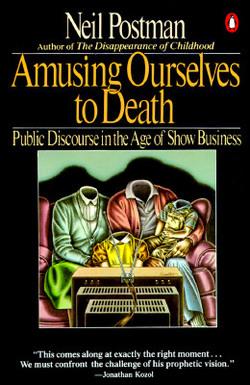
Book Scrounger's note: The following is a guest review by Doug, a.k.a. Professor Puzzler:
In 1985, Neil Postman wrote a frightening and prophetic book called Amusing Ourselves to Death, in which he analyzed the state of public discourse in the United States. In fact, he subtitled his book, "Public Discourse in the Age of Show Business."
This book should be required reading for all students before graduating high school.
In his foreword to the book, Postman explains the difference between Aldous Huxley's Brave New World and George Orwell's 1984 and then he writes, "What Orwell feared were those who would ban books. What Huxley feared was that there would be no reason to ban a book, for there would be no one who wanted to read one..." and "This book is about the possibility that Huxley, not Orwell, was right."
From there Neil Postman goes on to argue persuasively that we are becoming a society which would rather be entertained than informed, and that more and more the media will pander to our desire for entertainment, until we reach the point that all conversation is "sound bite conversation."
To me, the most extraordinary thing about this book is that Postman wrote it when the internet was in its infancy, and the concept of "social media" hadn't even entered anyone's minds. And yet, everything Postman wrote about in 1985 describes perfectly where we are as a society in 2016. Nobody wants to think deep thoughts or read in-depth analysis of anything. The basic premise of our society is: "If it can't be expressed as a facebook meme," it's not worth considering.
Postman, on the other hand, would probably have argued, "If it can be expressed as a facebook meme, it has been robbed of any surrounding context and is therefore good purely for entertainment." And even though Postman could not have predicted social media, he predicted the effect it is having on our society: it has become the cornerstone of our hunger for entertainment over understanding.
And it's not just reading, it's also listening. Postman writes about the Lincoln-Douglas debates, in which presidential candidates debated policy for three hours straight, took a one-hour break for supper, and then continued three more hours. And the hall was packed with spectators. Imagine that! People thought it was worth their time to sit and listen to people argue policy for six hours in one day! Today, debates have become circuses in which we're more interested in watching a trainwreck than listening to anything substantive.
It reminds me of a quote which is often (and probably incorrectly) attributed to Mark Twain: "The person who does not read has no advantage over the person who cannot read." We have become a society that can't be bothered to learn, study, read, and understand. And so we are no better than a society that can't do any of those things.
Format: Paperback
Author: Neil Postman
Pages: 163
Content Advisory: None
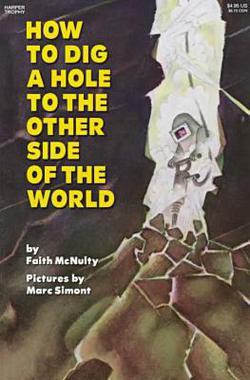
How to Dig a Hole to the Other Side of the World was written by Faith McNulty, and illustrated by Marc Simont in 1979. This book is the perfect mix of silliness and scientific instruction for children, and is recommended for ages 4 to 8.
I remember, as a child, wondering if it was possible to dig a hole "to China" (never mind that I'm not geographically opposite China -- that was always "the other side of the world" to us). I think every child wonders this at some point. This book explores the challenges we would face in digging such a hole, and describes the things we would discover as we did so.
Along the way, we learn about different kinds of rocks, and about volcanoes and geysers, which gave rise to all sorts of questions when we read this to our then-3-year-old.
As you progress in your journey through the earth, you have to go from digging with a shovel to digging with a jackhammer, to wearing an asbestos suit (this book was written before asbestos-based fire-proximity suits were phased out in favor of other materials), to riding in a submarine with a super-cooling system, a fireproof skin, and a drilling mechanism.
All in all, this book does a great job of introducing young children to the size and structure of our planet in an engaging way, and provides launching points for discussion of further topics.
Scrounged From: PaperbackSwap.com
Format: Paperback
Author: Faith McNulty
Illustrator: Marc Simont
Pages: 32
Content Advisory: None

